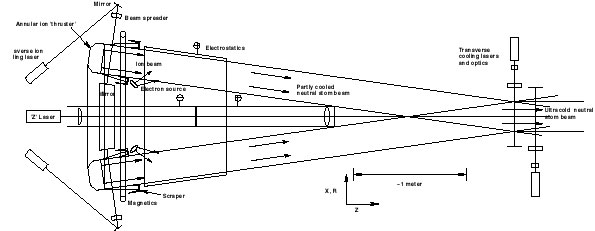Ultracold Matter Beam Generators for Space Development
Forrest Bishop*
Institute of Atomic-Scale Engineering,
Seattle, WA 98103
This is an abstract
for a presentation given at the
Eighth
Foresight Conference on Molecular Nanotechnology.
There will be a link from here to the full article when it is
available on the web.
The advent of laser cooling and manipulation of diffuse, ultracold matter will find many kinds of applications in space exploration and development. Near and mid-term possibilities include the shipment of streams of ultracold gas or its condensate over distances of hundreds or perhaps millions of kilometers, the formation of artificial aerobraking corridors and beam propulsion for micro and nanospacecraft.
Several designs for "Ultracold Matter Beam Generators" are proposed specifically for, though not limited to, use on the Lunar surface for launching material into space, for providing an "Artificial Reentry Corridor", and for matter beam propulsion. Designs variants include a laser-cooled thermal jet based on recent experiments, a laser-accelerated and cooled beam, and a laser-cooled, neutralized ion beam based on current ion thrusters. The equipment for a commercially viable device might be quite compact, with characteristic barrel lengths on the order of one meter. The generated atomic or molecular beam may have an initial launch temperature in the millikelvin range or lower. A launch velocity of 1-10 km/sec would then give a matter beam dispersion on the order of a milliradian or less- the central issue of propagating a particle beam in free space. A higher launch velocity would of course reduce this dispersion.
Since its introduction in the late 1970's, laser cooling and trapping has made some very impressive advances in fields as diverse as high-resolution spectroscopy, atomic-transition timekeeping, atom interferometry atom lithography reflecting and imaging atomic beams, the formation and characterization of optical lattices, and the creation of a heretofore theoretical state of matter- the Bose-Einstein Condensate and its associated "atom laser". Materials used to date for ultracold atom beams and traps include isotopes of Na, Cs, Rb, Cr, He, Ne, Ar, Xe, atomic H, and Al. There do not appear to be any serious proposals to date to develop this class of technology for space applications.
A reference design of one gram per second launched at a nominal 2 km/sec is used for comparison between different systems and for feasibility studies. Two solutions are explored in more depth, the laser cooled thermal beam and the laser-cooled, neutralized ion beam.

|
| Preliminary design concept for a laser-cooled neutralized ion beam generator. © 2000 Forrest Bishop
|
*Corresponding Address:
Forrest Bishop
Manager, Interworld Productions, LLC
Chairman, Institute of Atomic-Scale Engineering
E-mail: [email protected]
Web: http://www.speakeasy.org/~forrestb
|